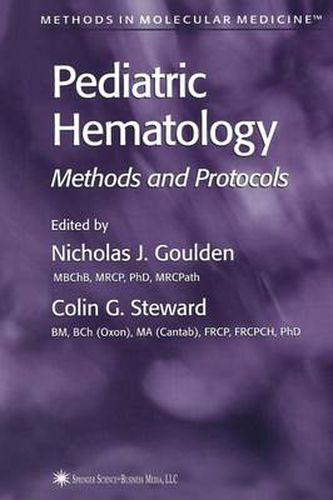Readings Newsletter
Become a Readings Member to make your shopping experience even easier.
Sign in or sign up for free!
You’re not far away from qualifying for FREE standard shipping within Australia
You’ve qualified for FREE standard shipping within Australia
The cart is loading…






This title is printed to order. This book may have been self-published. If so, we cannot guarantee the quality of the content. In the main most books will have gone through the editing process however some may not. We therefore suggest that you be aware of this before ordering this book. If in doubt check either the author or publisher’s details as we are unable to accept any returns unless they are faulty. Please contact us if you have any questions.
Much of the progress in the diagnosis, classification, and treatment of childhood hematological disorders has come from a partnership between clinicians and scientists. Indeed, access to molecular techniques is now an integral part of the practice of modern pediatric hematology. The aim of Pediatric Hematology: Methods and Protocols is to provide a collection of scientific protocols that cover the major aspects of the discipline. Most clinicians will be familiar with the difficulties inherent in establishing the underlying diagnosis in genetic marrow failure syndromes. A particular concern is failure to diagnose those associated with DNA repair defects. In Chapter 1, Dokal and colleagues present simple protocols for the molecular investigation of Fanconi anemia and dyskeratosis congenita. Molecular diagnosis is also important in children with congenital pure red cell aplasia, owing to the highly variable phenotype of this condition. In Chapter 2, Ball describes relevant protocols for the investigation of Diamond-Blackfan anemia. Hereditary hemoglobinopathy is a major cause of death and morbidity throughout the world. This area has seen great advances in screening and antenatal diagnosis. In Chapter 3, Old details protocols for the molecular diagnosis of most forms of hemoglobinopathy. High-quality, accurate molecular testing on small amounts of material has been fundamental to progress in antenatal diagnostics. The introduction to his comprehensive chapter includes a discussion of the general principles that underpin these studies. In contrast to hemoglobinopathy, severe hemophilia is uncommon.
$9.00 standard shipping within Australia
FREE standard shipping within Australia for orders over $100.00
Express & International shipping calculated at checkout
This title is printed to order. This book may have been self-published. If so, we cannot guarantee the quality of the content. In the main most books will have gone through the editing process however some may not. We therefore suggest that you be aware of this before ordering this book. If in doubt check either the author or publisher’s details as we are unable to accept any returns unless they are faulty. Please contact us if you have any questions.
Much of the progress in the diagnosis, classification, and treatment of childhood hematological disorders has come from a partnership between clinicians and scientists. Indeed, access to molecular techniques is now an integral part of the practice of modern pediatric hematology. The aim of Pediatric Hematology: Methods and Protocols is to provide a collection of scientific protocols that cover the major aspects of the discipline. Most clinicians will be familiar with the difficulties inherent in establishing the underlying diagnosis in genetic marrow failure syndromes. A particular concern is failure to diagnose those associated with DNA repair defects. In Chapter 1, Dokal and colleagues present simple protocols for the molecular investigation of Fanconi anemia and dyskeratosis congenita. Molecular diagnosis is also important in children with congenital pure red cell aplasia, owing to the highly variable phenotype of this condition. In Chapter 2, Ball describes relevant protocols for the investigation of Diamond-Blackfan anemia. Hereditary hemoglobinopathy is a major cause of death and morbidity throughout the world. This area has seen great advances in screening and antenatal diagnosis. In Chapter 3, Old details protocols for the molecular diagnosis of most forms of hemoglobinopathy. High-quality, accurate molecular testing on small amounts of material has been fundamental to progress in antenatal diagnostics. The introduction to his comprehensive chapter includes a discussion of the general principles that underpin these studies. In contrast to hemoglobinopathy, severe hemophilia is uncommon.